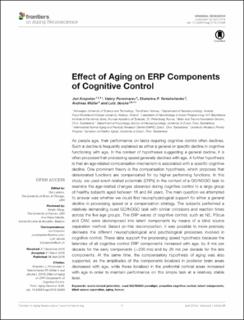| dc.contributor.author | Kropotov, Yury | |
| dc.contributor.author | Ponomarev, Valery A. | |
| dc.contributor.author | Tereshchenko, Ekaterina P | |
| dc.contributor.author | Müller, Andreas | |
| dc.contributor.author | Jäncke, Lutz | |
| dc.date.accessioned | 2020-04-28T14:25:16Z | |
| dc.date.available | 2020-04-28T14:25:16Z | |
| dc.date.created | 2016-12-06T11:25:31Z | |
| dc.date.issued | 2016 | |
| dc.identifier.citation | Frontiers in Aging Neuroscience. 2016, 8:69 | en_US |
| dc.identifier.issn | 1663-4365 | |
| dc.identifier.uri | https://hdl.handle.net/11250/2652819 | |
| dc.description.abstract | As people age, their performance on tasks requiring cognitive control often declines. Such a decline is frequently explained as either a general or specific decline in cognitive functioning with age. In the context of hypotheses suggesting a general decline, it is often proposed that processing speed generally declines with age. A further hypothesis is that an age-related compensation mechanism is associated with a specific cognitive decline. One prominent theory is the compensation hypothesis, which proposes that deteriorated functions are compensated for by higher performing functions. In this study, we used event-related potentials (ERPs) in the context of a GO/NOGO task to examine the age-related changes observed during cognitive control in a large group of healthy subjects aged between 18 and 84 years. The main question we attempted to answer was whether we could find neurophysiological support for either a general decline in processing speed or a compensation strategy. The subjects performed a relatively demanding cued GO/NOGO task with similar omissions and reaction times across the five age groups. The ERP waves of cognitive control, such as N2, P3cue and CNV, were decomposed into latent components by means of a blind source separation method. Based on this decomposition, it was possible to more precisely delineate the different neurophysiological and psychological processes involved in cognitive control. These data support the processing speed hypothesis because the latencies of all cognitive control ERP components increased with age, by 8 ms per decade for the early components (<200 ms) and by 20 ms per decade for the late components. At the same time, the compensatory hypothesis of aging was also supported, as the amplitudes of the components localized in posterior brain areas decreased with age, while those localized in the prefrontal cortical areas increased with age in order to maintain performance on this simple task at a relatively stable level. | en_US |
| dc.language.iso | eng | en_US |
| dc.publisher | Frontiers Media | en_US |
| dc.rights | Navngivelse 4.0 Internasjonal | * |
| dc.rights.uri | http://creativecommons.org/licenses/by/4.0/deed.no | * |
| dc.title | Effect of aging on ERP components of cognitive control | en_US |
| dc.type | Peer reviewed | en_US |
| dc.type | Journal article | en_US |
| dc.description.version | publishedVersion | en_US |
| dc.source.volume | 8:69 | en_US |
| dc.source.journal | Frontiers in Aging Neuroscience | en_US |
| dc.identifier.doi | 10.3389/fnagi.2016.00069 | |
| dc.identifier.cristin | 1408858 | |
| dc.description.localcode | Copyright © 2016 Kropotov, Ponomarev, Tereshchenko, Müller and Jäncke. This is an open-access article distributed under the terms of the Creative Commons Attribution License (CC BY). The use, distribution and reproduction in other forums is permitted, provided the original author(s) or licensor are credited and that the original publication in this journal is cited, in accordance with accepted academic practice. No use, distribution or reproduction is permitted which does not comply with these terms. | en_US |
| cristin.ispublished | true | |
| cristin.fulltext | original | |
| cristin.qualitycode | 1 | |

